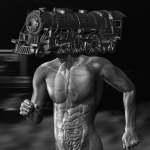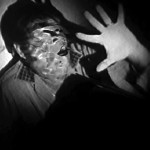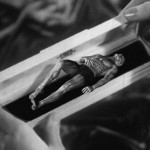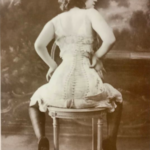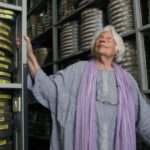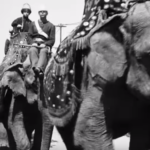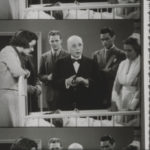The Mysterious Videos of Bill Domonkos
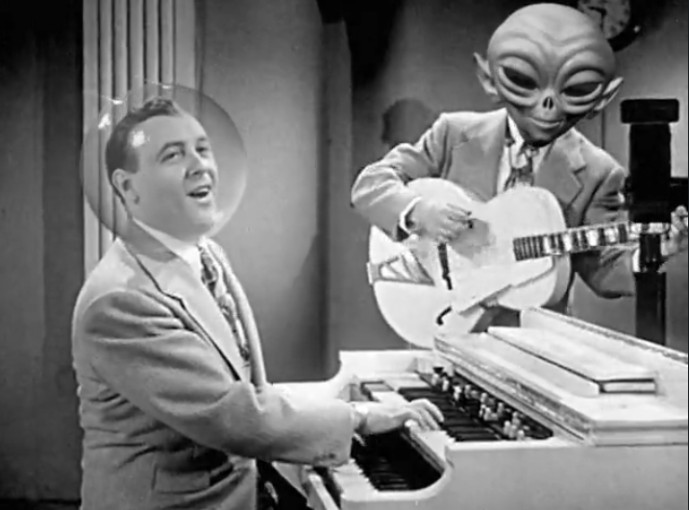
A still from Domonkos’ “Beyond The Blue Horizon.”
n
By Wheeler Winston Dixon
Stock-footage filmmaking has been around almost since the inception of the medium itself, and numerous examples of archival-based cinema have become staples of film history, such as the Why We Fight series of World War II morale builders created almost entirely out of existing materials under the general supervision of Frank Capra between 1942 and 1945. But the use of stock footage in an ironic, pop-culture context didn’t really begin to surface in earnest until the late 1950s and early 1960s, with such landmark films as Bruce Conner’s A Movie (1958); Cosmic Ray (1962), which contains both found and original materials; and Conner’s heartbreaking film essay on the assassination of John F. Kennedy, Report (1966).
In Conner’s wake, many other artists of the period, such as Robert Nelson, Charles Levine, and others also began to use stock footage in their films, as a form of cultural criticism, juxtaposing the staged cinematic version of life with the real world, to visibly demonstrate the gap between the “movie” version of the world and the vicissitudes of our shared daily existence.
But Bill Domonkos is taking stock-footage filmmaking in an entirely different direction, moving into the dream world of the unconscious. Using Public Domain found materials, almost exclusively in black and white, mostly from the Internet Archive and The Prelinger Collection, Domonkos creates a dream world of phantasmal and sometimes sinister images that transport the viewer to an entirely different place and time, when black and white was the dominant form of filmmaking, and the repressive values of the 1940s and 1950s went unquestioned.
{Click on an image to expand}
[Above, images from Orgone-Beat, My Funny Valentine, and Meantime.]
Beginning in 2001, Domonkos has created a series of roughly 30 brief and enigmatic black and white films that have developed a cult following online, and attracted international attention in the media. The end result is HD video, but all the source materials are resolutely film, usually in 35mm format. As I wrote in my blog Frame by Frame on 14 July 2016:
The video work of Bill Domonkos is at once mysterious and sublime, mixing 1940s and 50s pop culture with 21st century surrealism. As Michael Hardy notes in The Boston Globe, “Spooky. Hypnotic. Lush. Witty. Sublime. The extraordinary films of San Francisco-based artist Bill Domonkos call up a descriptive vocabulary that never seems to capture the fluidity, the aesthetic metamorphoses, of the director’s vision.” That’s a fitting enough description for starters, but what Domonkos does with found footage and editorial techniques is truly remarkable, creating an entirely new world in which the unreal is real, and the most extraordinary images and juxtapositions seem entirely natural.
Of his work, Domonkos himself notes, “I view my work as a collision and recombination of ideas. My process unfolds gradually and spontaneously—using found materials such as archive film footage, photographs, and the internet. I experiment by combining, altering, editing and reassembling using digital technology, special effects and animation to create a new kind of experience. I am interested in the poetics of time and space—to renew and transform materials, experiences and ideas. The extraordinary thing about cinema is its ability to suggest the ineffable—it is this elusive, dreamlike quality that informs my work.”
A regular figure on the gallery circuit, one can thankfully see a great deal of Domonkos’ work on Vimeo, although a certain amount of discretion is advised, as some of his work can be quite dark indeed. In general, I favor his lighter, more accessible work, gently playful in some instances, slightly sinister in others. Most of the videos are in the two-to-three-minute range, and his works covers a wide ranges of themes and approaches.
My favorites are such videos as Sisyphus [2013], in which a nondescript executive in a 1950s elevator is suddenly illuminated with a celestial light from above, as a mysterious rock descends through the elevator shaft to cover his face, intercut with an elderly workman clambering up and down the interior of the building, inspecting the elevator’s exterior with a flashlight. There’s no real reason for any of the images here, which is entirely the point; these things just happen in Domonkos’ world, and that’s all there is to it.
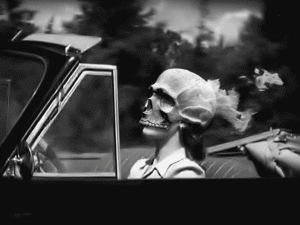
From “Dinah Soar” by Bill Domonkos.
Another favorite is Dinah Soar (2016), in which a young woman is first seen putting on makeup with the aid of a rather unusual machine, and then drives a sports car with a distinctly odd gearshift around a race track, only to be pursued by a group of racing-car drivers, even as her face, at first possessed of the flawless beauty of a fashion model, gradually changes into a smoking death’s head, while mechanical wind-up toys parade across the screen with childish abandon. Again, the precise meaning of these images, as well as the syntactical structure that unites them, is absolutely left up to the viewer; Domonkos creates a world in which anything is possible.
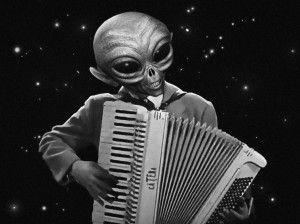
“Beyond the Blue Horizon”
But I think that of all of Domonkos’ work, I’m drawn to those films in which the past and the present gently collide, such as Beyond The Blue Horizon (2015). In this brief video, a 1940s Soundie (a short, pre-MTV music video) by The Three Suns is transformed into a jam session between a human space helmeted organist / vocalist, singing the title song, while two Martian (or alien) sidemen accompany him on guitar and accordion, all of which is being recorded by an unobtrusive sound man in the rear of the shot.
Domonkos’ skill is such that the entire scene seems oddly realistic, even down to the three-second “cigarette burn” cue in the upper-right-hand corner of the frame as the video comes to an end. All in all, it’s a very unusual world indeed, a recombinant vision that in which the past and present meld together to create a world that is at once accessible, but which operates entirely according to its own lights — a peek into a modern day Twilight Zone of found footage and digital mastery.
Because Domonkos’ work is so original, and at the same time so difficult to classify, I conducted an interview with him on 3 August 2016 by telephone from his home in San Francisco, to get a better idea of the circumstances that informed the creation of his work. Born in Toledo, Ohio in 1959 to a father who worked as a television repairman, and a mother who worked as a payroll clerk while pursuing a hobby as a painter on the side, Domonkos began working in Super 8mm when he was given a camera as a gift. Almost immediately, he seemed to have found his niche, and displayed early on considerable skill with the techniques of filmmaking. As I asked him:
Wheeler Winston Dixon: Did you get some of your tech skills from your father? You seem very comfortable with tech, and he was a technician of that era.
Bill Domonkos: Yeah, I would say that is something that rubbed off on me. He was really good at fixing televisions, and we had one of the first color TVs on the block, so all the kids would come over and watch The Wizard of Oz [1939] and things like that as I was growing up.
Your mother was a payroll clerk, but she loved to paint and draw as hobbies. It seems like you’ve got two great influences going on. Your father is Mr. Tech, and your mother is Ms. Creative, in a sense. Did she encourage you to do work on your own, your mother?
You know, she did; she always drew and painted with me. She was always very encouraging, and she would draw portraits of people in the neighborhood. She’d paint Christmas scenes on mirrors and things like that; she wasn’t a professional painter. My father bought me a Super 8mm movie camera, and I was probably around ten or eleven. I started playing around with that, just shooting on family vacations, and Niagara Falls and things like that. Then I started experimenting, doing more narrative structured things with my friends. It started off doing little scenes of this and that, but the time before that though, I was putting on a lot of live shows and plays that I would write. I put them on in our garage, and charged a quarter to get in; I’d get 10 to 15 people in the audience. So I was doing this very early on.
I understand you made a Super 8mm “remake” of Mark Robson’s Valley of the Dolls [1967] when you were twelve years old. That sounds like a rather ambitious project. Could you tell me a bit about that?
I did, yes; for some reason I was fascinated with that movie. I had the little girls in the neighborhood, ten, eleven, twelve years old, playing drug-addicted Hollywood starlets [laughs]. It was pretty twisted. I didn’t do the sets for that one, but I directed it and photographed it. I also did the costumes. I was fortunate at the time, because everybody’s mothers had wigs in those days, so I could use those. That film is gone, though — it’s too bad.
You described your upbringing as very blue collar and very Catholic, and you went to Catholic schools for grades K through 12, correct?
That’s right.
You’ve said you think that perhaps maybe that’s where some of your “darkness” came from, because some of your films are quite dark indeed. One thing that I’ve also picked up on is the strong spiritual aspect to your films, that you feel deep sympathy for a lot of your stock footage “protagonists” in a way.
Yeah, I think that there is an element of darkness in my work that was certainly brought about by my Catholic upbringing. How could that not affect you? There was also this element of magic, and supernatural entities; this mystery that you would never know anything about. It was intoxicating, I think, especially for a kid, and it gives you a different perspective.
One thing you’ve said that struck me is that “looking back, there are so many teachers that had a profound effect on my life, and sadly they never knew that. Even I didn’t realize it at the time.”
Yeah, I think that’s definitely true. When you’re young and rebellious, you don’t want to listen to anyone. I think that a lot of times you don’t appreciate things that are happening to you at the time. You grow up and you mature, and then you realize that these people were right, actually. You just didn’t appreciate the lessons at the time, but eventually, they hit home.
When did you discover the Toledo Museum of Art, and what kind of impact did that have on you?
I would say in my middle teens, when I learned to drive. I spent a lot of time there. I just loved it; I was in heaven. It was just such a wonderful experience – they have a great collection of art; people call it “the Frick [Museum] of the West.” So I spent a lot of time there, soaking it all in.
When you were growing up, were you a movie junkie, watching TV all the time?
Of course, after school every day; The 4:00 Movie. That’s where I picked up a lot of the stuff I’m doing now; it was all ’40s and ’50s and of course, it was nearly all in black and white. I always loved horror movies, and I think that they came from my dad, because my dad was a really great storyteller. He used to tell these horror stories that he would make up. We would have bonfires in our backyard, and the neighborhood kids would come down, and he would tell these scary stories. But I was terrified of horror movies when I was a kid. It got to the point where my parents wouldn’t let me watch them anymore because I had nightmares. The old Universal films, like the Wolfman, and Dracula, the classic horror movies.
When I finished high school, I started taking classes at the Toledo Museum of Art, which was where the art classes for the University of Toledo were held. I had some really wonderful professors when I went there; I think those were certainly some of the people I was talking about when I was saying that I never really told some of my past professors what a difference they made in my life; they gave me the room to create my own work.
For example, in my first year of college, I took a creative-writing class, and for my final paper in the class, I wrote a story that was based on Dante’s Inferno, where every level of hell was a different Hitchcock movie. So I had freedom there to do what I wanted to do; it was really liberating.
Around 1995, I graduated with a BA in sculpture and video art, and my father and mother had both died, so I decided it was time to pull up stakes and get out of Toledo. I was ready to go. So I moved to San Francisco, though I had a job along the way in Dayton, Ohio, teaching video classes at a Public Access station, which was a really great experience — one of the happiest times of my life. I’d teach during the day, and then shoot my own stuff off the clock, and I got a chance to really hone my skills.
But when I got to San Francisco, I didn’t have a job or anything. My brother was living there, and this was at the beginning of the dot.com boom. Video games, CD-ROMs – all that stuff was really picking up speed, and I had already started to do computer animation on an Amiga 64 [computer]. I was using an Amiga 64 up until the time I moved to San Francisco [laughs]. I had to buy a Mac in order to get work, because that’s what everybody was working on.
What kind of work do you do for commercial work? Video games, animation, apps, things like that?
Yeah, it’s all those things; I design some apps, and some games. I do fewer games now; I was doing more games early on when I moved here. The first project that I got when I moved here was with the rock-&-roll band The Residents on a CD-ROM that they did called Bad Day on the Midway.
When did you suddenly decide that you were going to embrace the world of black and white, and particularly the archival world of black and white? In a certain sense, it seems to me that you live in this universe, a black-and-white universe.
I think that the popularity of the Internet had a lot to do with that, because that stuff was more readily available. The first film that I used archival material in was The Fine Art of Poisoning [2002]; I used photographs that I found at flea markets, and scanned them, and altered them, and animated them.
It seemed to me that The Fine Art of Poisoning was a meeting of Salvador Dali, Luis Buñuel, Charles Addams, the cutout films of Lotte Reiniger, Universal horror movies, Edward Gorey – there’s a lot of things going on in the film. And, as you say, it’s all found materials. Do you prefer working with found materials to shooting stuff yourself?
I do, I love it. I don’t see any end to it, because there’s so many possibilities. The thing that I love about it, more than anything else is that I never know where it’s going to end up. It’s like working a puzzle. You just have to get all the pieces just right for it to work. You don’t know where the pieces go until you start putting them together, and then you realize, “this goes here, and that goes there” and so on. The next thing you know, you’ve created the film.
The filmmaker Nathaniel Dorsky once said to me, “you look for the form that rises out of the material.” You have the material for your film, however you get it, and then when you get into the editing room, you look at what the material says to you. Then that’s the thing that arises out of that.
Yeah, that’s absolutely the truth, and it’s really important, the way that I work, to be playful and spontaneous. I never sit down and plan how a film is going to fit together. It’s all trial and error. That’s one of the great things about working that way; you juxtapose the most unexpected things, but then you get that sense that that’s just exactly right. I can’t even articulate exactly what it is that makes it right in most cases, but I just know when it’s done.
It’s poetry.
It is, exactly.
This really comes through in your work. As one example, your film My Funny Valentine [2014] deals with a man cowering in the corner of a room, his face entirely disfigured by CGI manipulation. He’s done something — we don’t know what — and then the police come and take him away, while his neighbors look on impassively. It’s all fifties recycled footage, but what struck me most is that you seem to have such sympathy for this man.
Yeah, and a lot of that has to do with the footage that I worked with too. I become so familiar with the footage that I use, that I actually treat the people in them as if they’re actors, playing out a part. All of that stuff has to come together for it to work, and there’s certainly a lot of things I do that don’t work out. It’s a laborious process, but I love it.
Getting back to black and white, it’s so unreal, it’s just a whole other world. I have done a couple films in color, but they’re not my favorite work. There’s even been a couple of films that I did color and went back and turned them into black and white. Black and white transforms the universe instantly, but it does it in a way that people don’t even acknowledge. And yet it changes everything.
I agree. For example, in Meantime [2014], images of a pocket watch being assembled segue into a shot of the watch’s internal mechanism ticking away, and then to a close-up of a young man sleeping in bed. Slowly the skin on the man’s face rips apart to reveal his internal “mechanism” in a sequence that’s both compelling and deeply surreal. Later, as if in a dream, we’re shown an image of a miniature man resting in a watch case. It’s a remarkable use of repurposed existing materials.
It’s true; you have to let the images guide you. On my earlier film The Ambient Medium [2007], the inspiration actually came from 19th century spirit photography, which was my primary point of departure, so to speak. Then the rest of it just came together. I actually created it for a projection on a building in downtown Oakland, and they didn’t have sound. When I made the film for that, I liked it so much that I decided to go back and add sound to it afterwards.
It seems to me that you’re moving away from narrative structures in your more recent films like Sisyphus [2013], Dinah Soar [2016], and particularly the relentless Orgone-Beat [2015] – which is just one continuous loop of a multi-headed being running down a seemingly endless stretch of railroad track – as if you’re saying, “who really needs narrative? The images are all here. Why explain things?”
I’d agree; who needs to explain? The images are open to lots of different interpretations. I also think that the animated gifs that I’ve been doing has influenced that, too. They’re mini-movies, as you know; just one scene in perpetual motion.
Your gifs are quite arresting and mysterious; they’re also very popular with your fans. Indeed, they’re all over the place; how do you feel about that? If people appropriate your gifs, is that okay with you?
Yeah, I have no problem with that. After all, I appropriated the images from their original sources, too. I think it’s only right to put all the work out there. It’s funny, because early on, when I was making films, I spent a lot of time and energy on the film festival circuit. Ultimately, I found it to be very frustrating, especially for a short filmmaker, especially when the Internet was coming into full bloom. It’s much easier to put them all on Vimeo, and you reach a wider audience.
Okay, and now the lightning round; a few last fast questions. How do you feel about contemporary culture, and particularly the arts? What do you think about pop culture today?
I think I feel overwhelmed by contemporary culture. It’s just too much.
Do you feel any responsibility to the audience to your work, or are you just working to please yourself?
I think that I work to please myself, which makes sense. Who knows who my audience is? I do the things that feel right to me.
Do you feel now, in terms of the Internet, that we are all more interconnected, or pushed further apart?
Creatively, the Internet has been a huge blessing to me, because it has gotten me in touch with people from all over the world, whom I’ve subsequently collaborated with. Not only is it possible to connect with these people really easily, but also you don’t even have to speak their language.
That’s a great point.
I’m working with people in Portugal and France, and we translate everything with Google Translation. I think that that’s really wonderful; certainly you couldn’t collaborate with somebody twenty years ago like you can today. I would never have met any of these people from all over the world, which is wonderful.
On the other hand, I stare into “the black mirror” of my computer all day long [a reference to Charlie Brooker’s brilliant British Dystopian science-fiction television series The Black Mirror about future technology gone wrong; the series ran on Channel 4 in the UK for two seasons from 2011 to 2014; an American version is now in production on Netflix for release in late 2016]. So to answer your question, yes and no; there’s things that I absolutely love about working online, but there’s a downside, too.
Do you feel in a sense that you’re embracing the past, and bringing the culture of the past forward? Perhaps returning to the wonder of childhood?
I think that there’s definitely a sense of wonderment that comes through in some of my films, absolutely. The whole idea is to create an alternate universe. I guess ultimately I want to transport the viewer into a totally different world from the everyday one they know, and take for granted. There’s a whole universe of images out there, waiting to be harvested, and that’s what I’m doing; I don’t think I’ll ever run out of material, or ideas.
Thanks, Bill – I look forward to more of your work.
My pleasure – great talking with you!
 Wheeler Winston Dixon is the James Ryan Professor of Film Studies, Coordinator of the Film Studies Program, and Professor of English at the University of Nebraska, Lincoln. With Gwendolyn Audrey Foster, he is editor of the book series Quick Takes: Movies and Popular Culture for Rutgers University Press. His newest books are Black and White Cinema: A Short History (2015), Dark Humor in Films of the 1960s (2015), Cinema at the Margins (2013), Streaming: Movies, Media and Instant Access (2013); Death of the Moguls: The End of Classical Hollywood (2012); 21st Century Hollywood: Movies in the Era of Transformation (2011, co-authored with Gwendolyn Audrey Foster); A History of Horror (2010), and Film Noir and the Cinema of Paranoia (2009). Dixon’s book A Short History of Film (2008, co-authored with Gwendolyn Audrey Foster) was reprinted six times through 2012. A second, revised edition was published in 2013; the book is a required text in universities throughout the world. Forthcoming is his Hollywood in Crisis: Or, The Collapse of The Real (2016).
Wheeler Winston Dixon is the James Ryan Professor of Film Studies, Coordinator of the Film Studies Program, and Professor of English at the University of Nebraska, Lincoln. With Gwendolyn Audrey Foster, he is editor of the book series Quick Takes: Movies and Popular Culture for Rutgers University Press. His newest books are Black and White Cinema: A Short History (2015), Dark Humor in Films of the 1960s (2015), Cinema at the Margins (2013), Streaming: Movies, Media and Instant Access (2013); Death of the Moguls: The End of Classical Hollywood (2012); 21st Century Hollywood: Movies in the Era of Transformation (2011, co-authored with Gwendolyn Audrey Foster); A History of Horror (2010), and Film Noir and the Cinema of Paranoia (2009). Dixon’s book A Short History of Film (2008, co-authored with Gwendolyn Audrey Foster) was reprinted six times through 2012. A second, revised edition was published in 2013; the book is a required text in universities throughout the world. Forthcoming is his Hollywood in Crisis: Or, The Collapse of The Real (2016).
Previous Post: Nitrate Film Makes A Comeback
Next Post: "Race Films" – Little-Known Screen Gems

